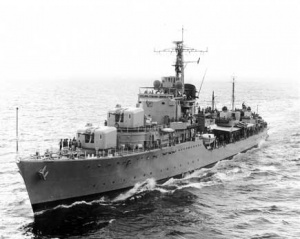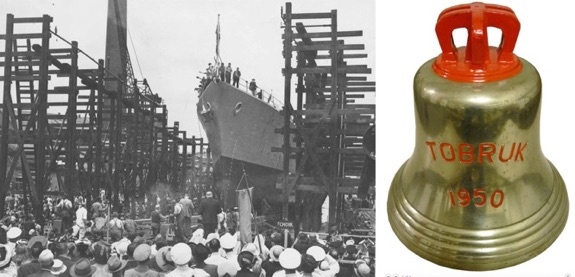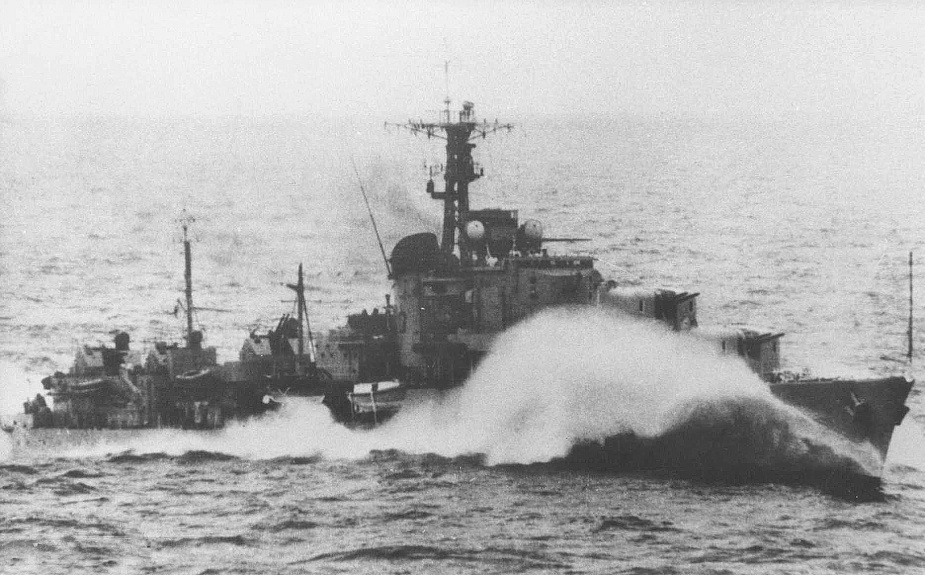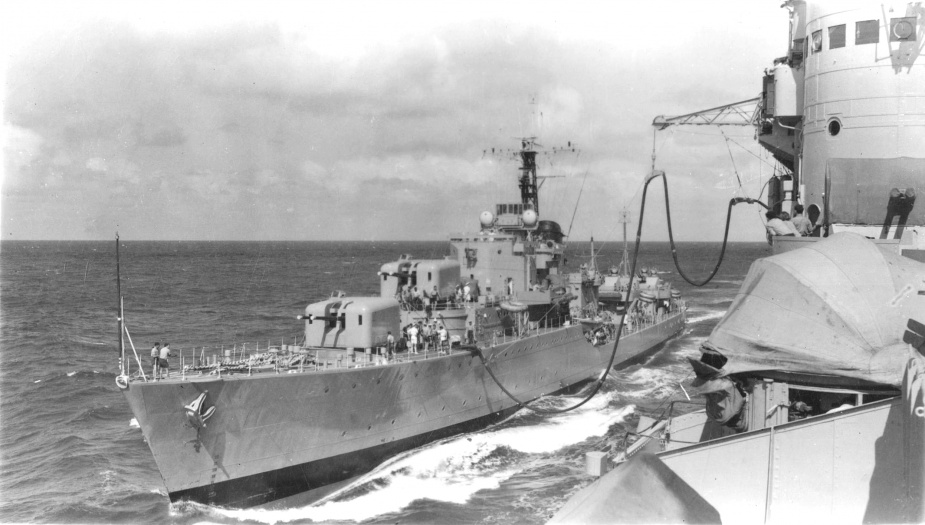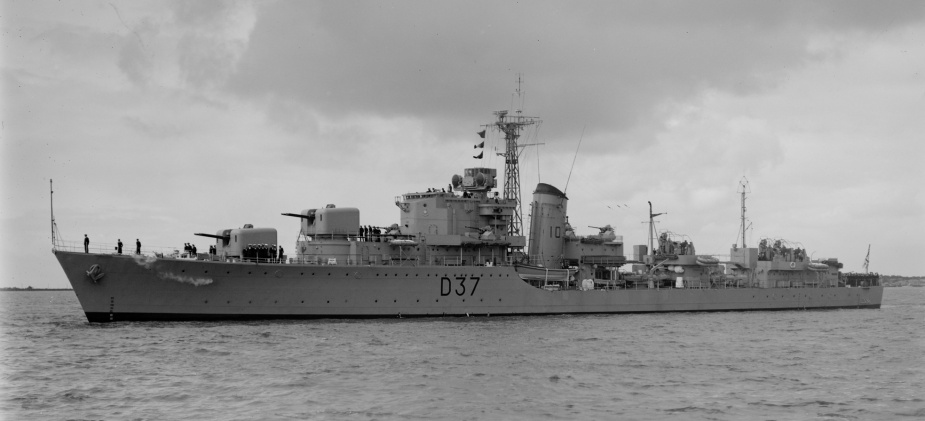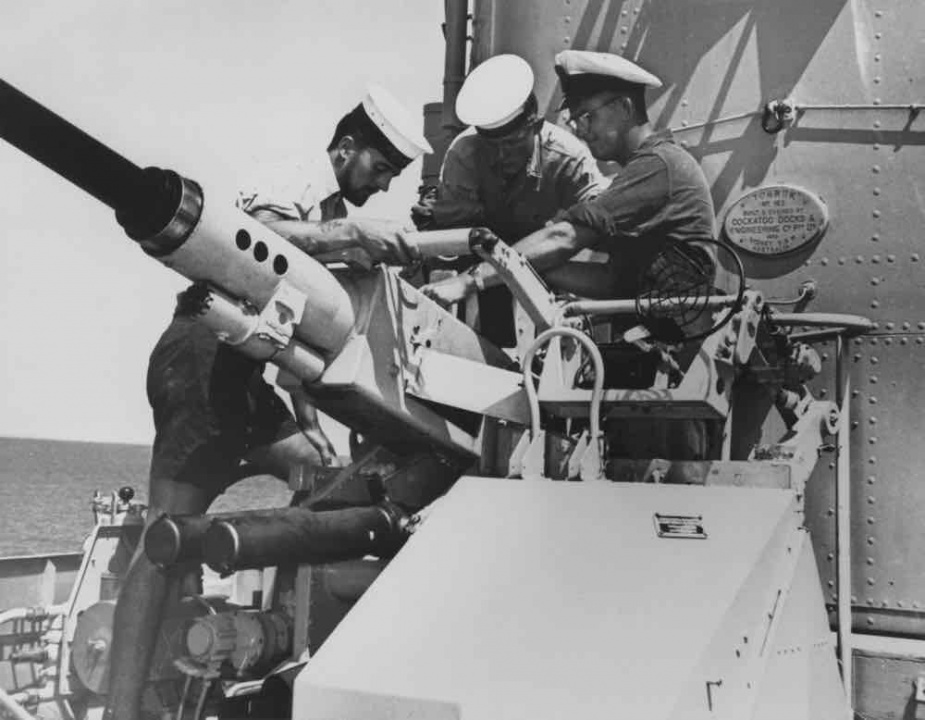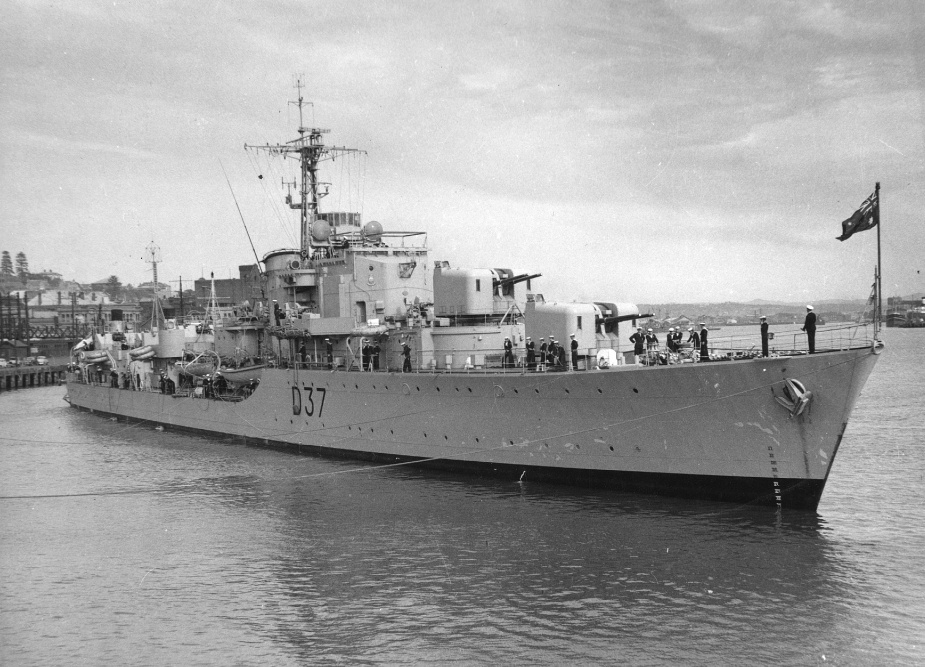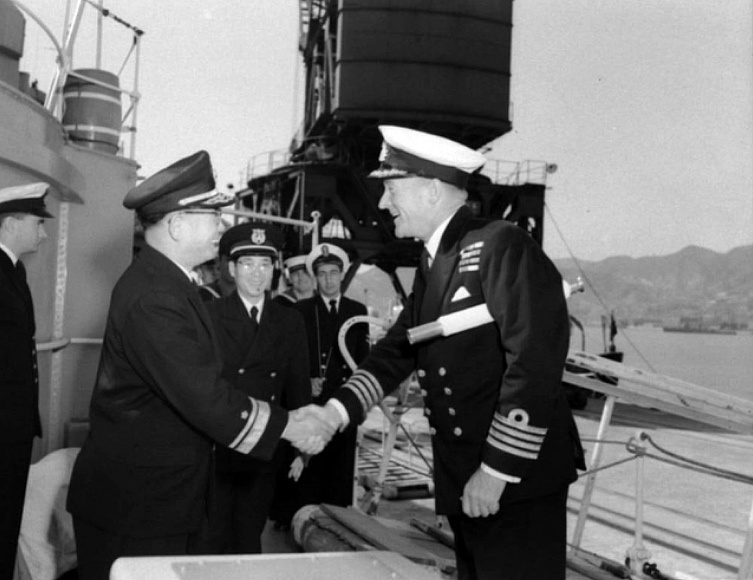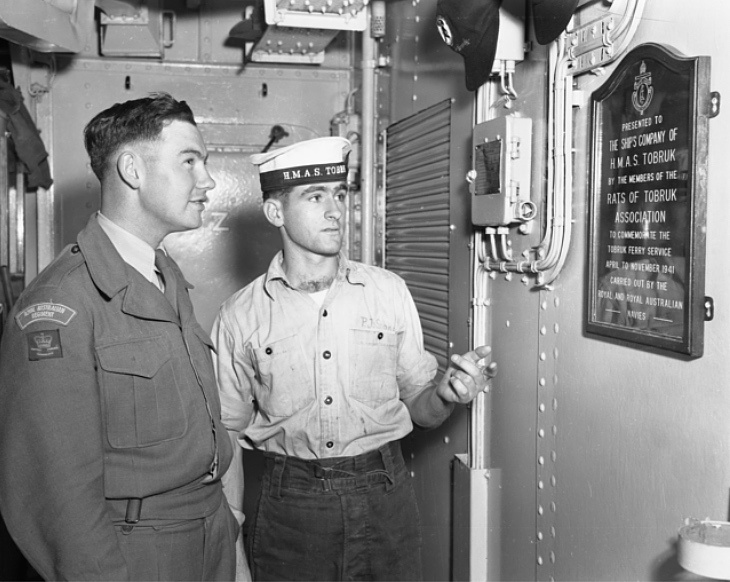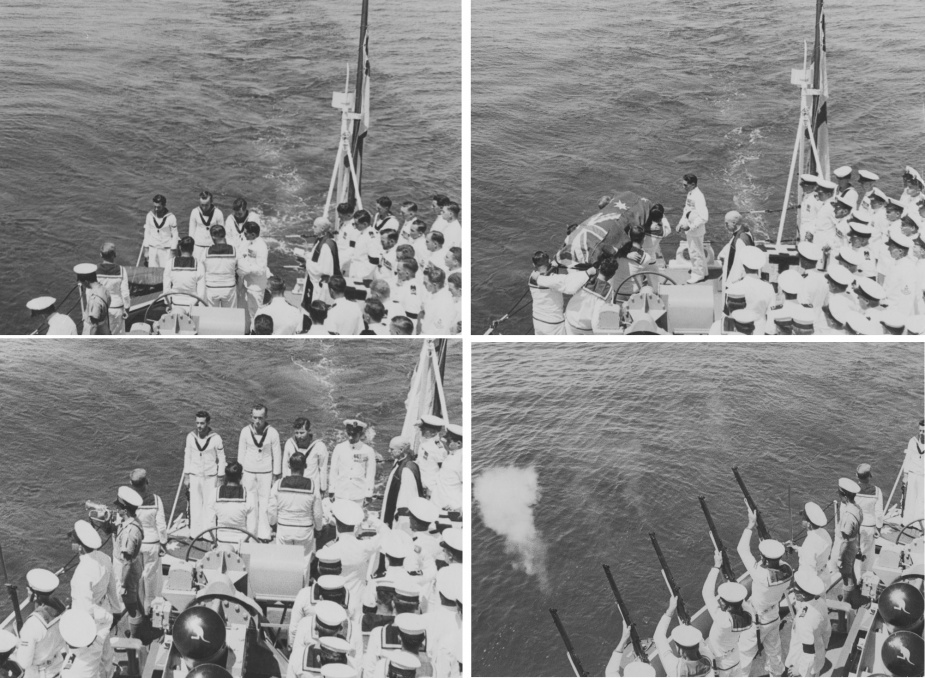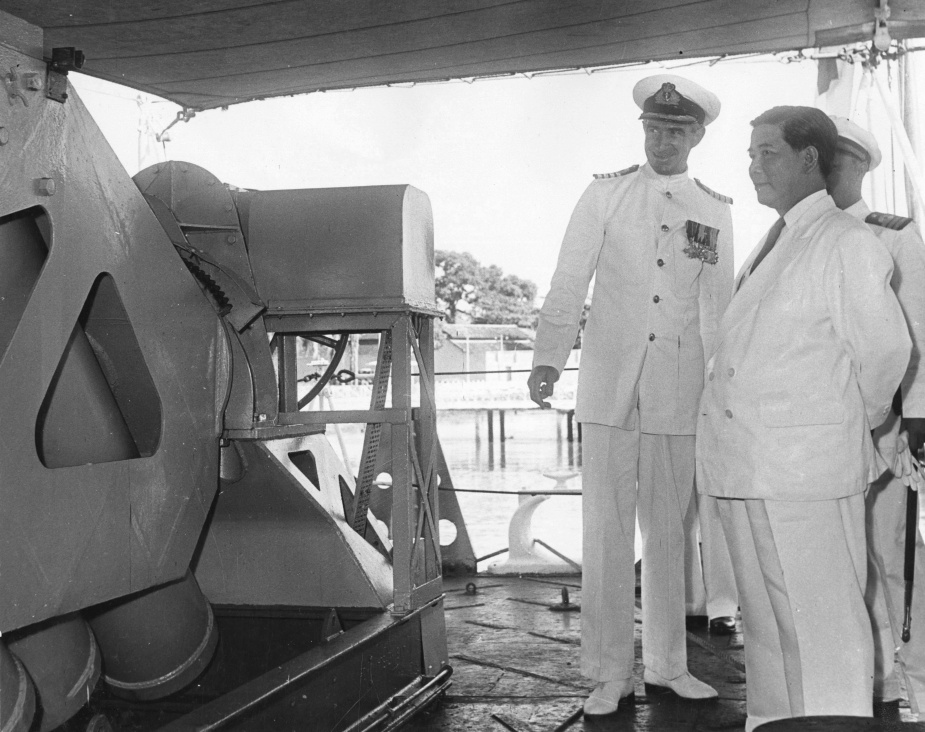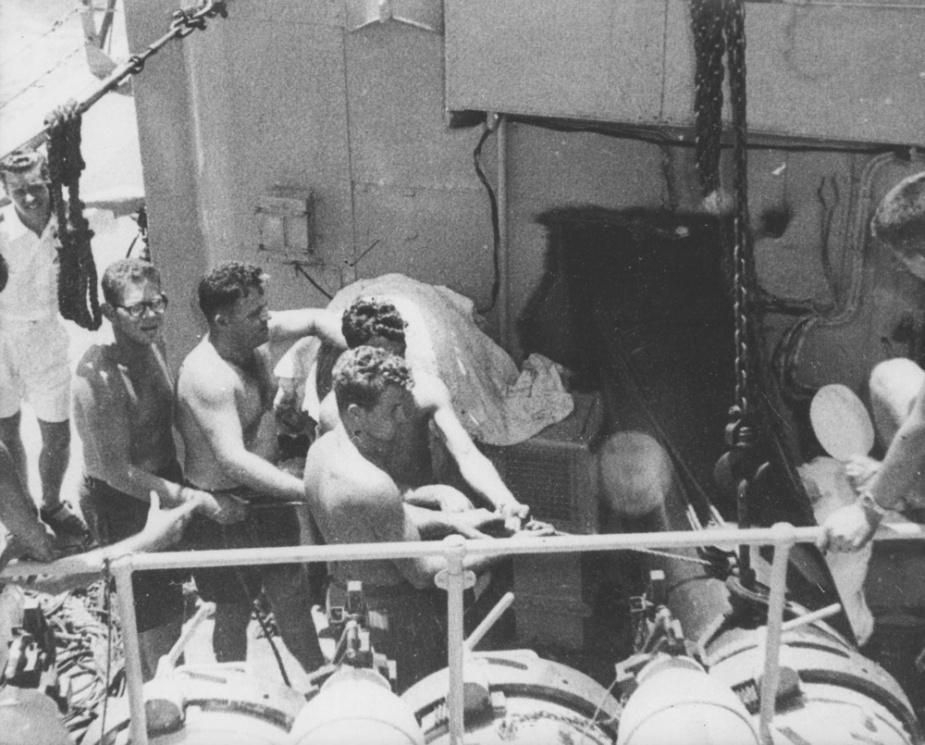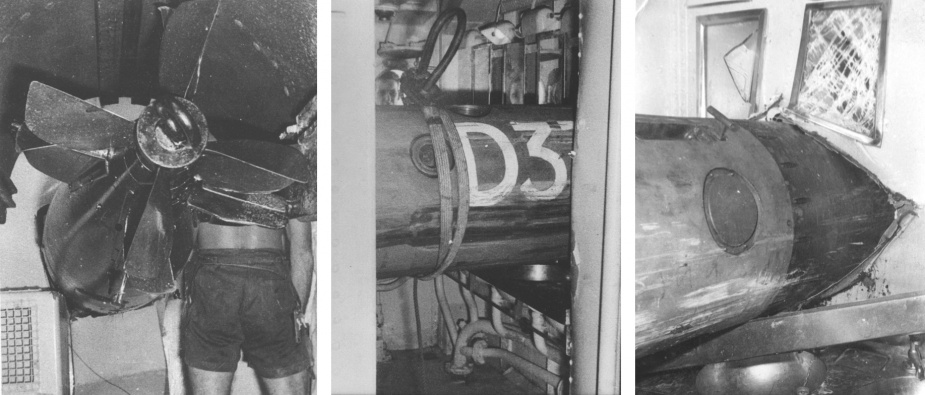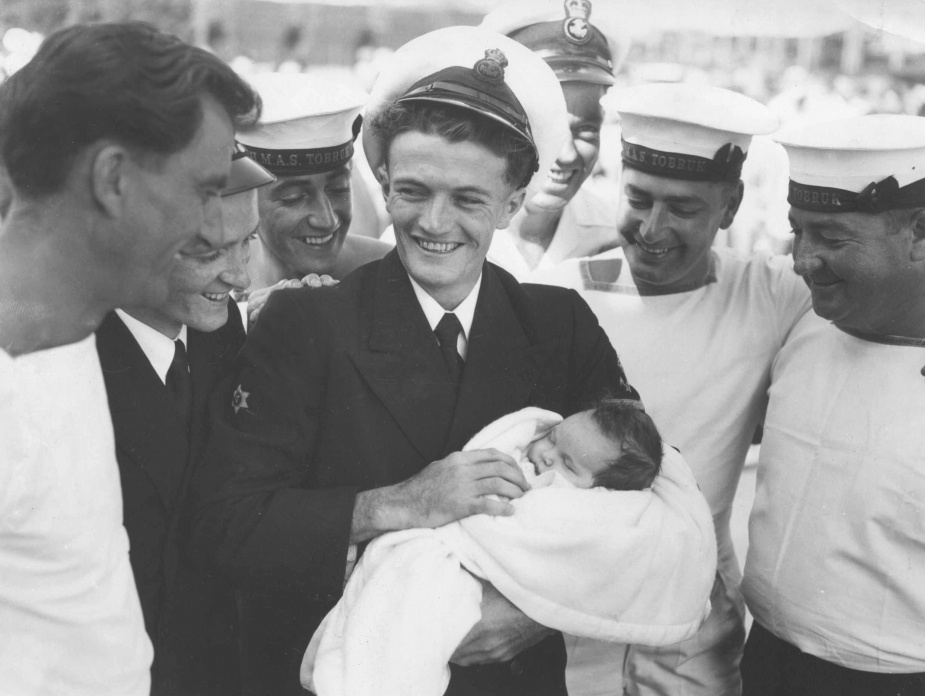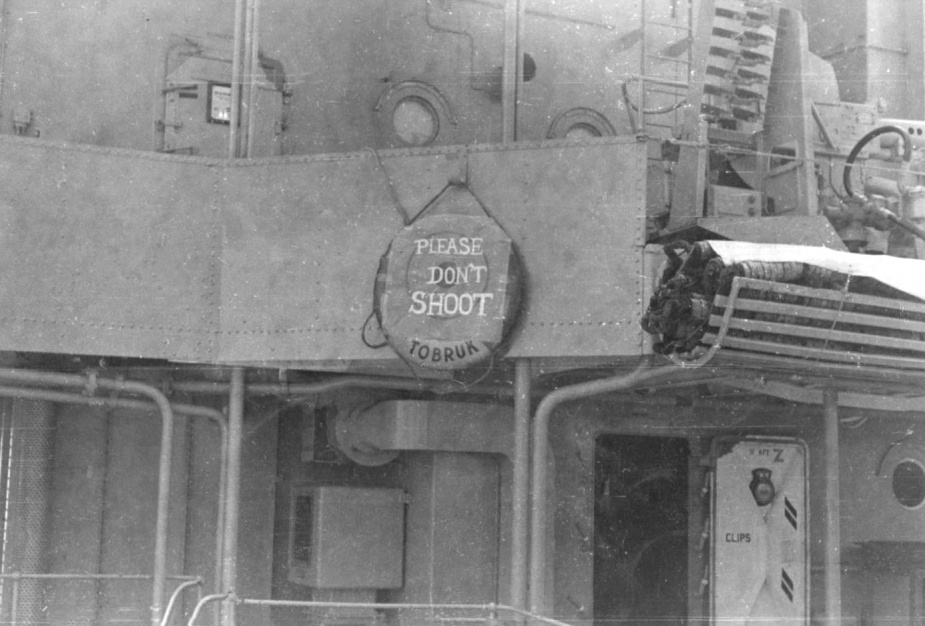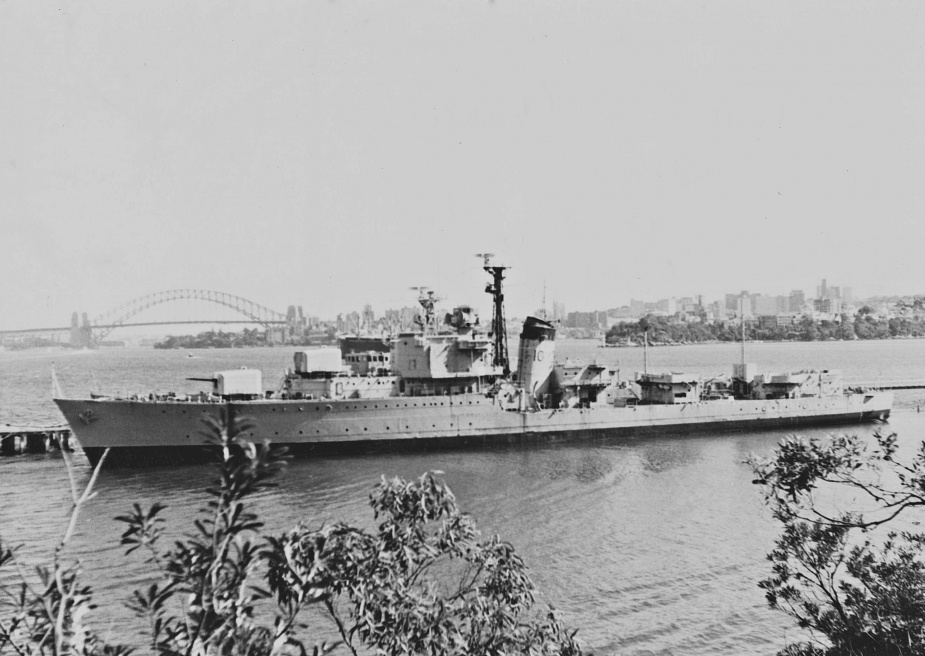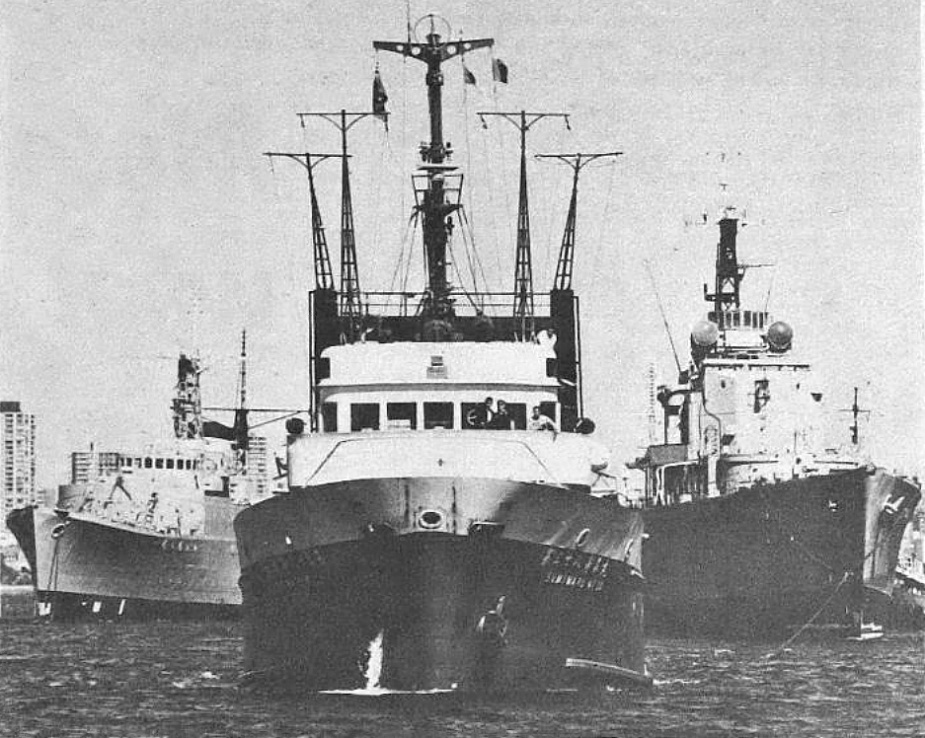HMAS Tobruk (I)
| Class |
Battle Class |
|---|---|
| Type |
Destroyer |
| Pennant |
D37 |
| Builder |
Cockatoo Docks and Engineering Co Pty Ltd, Sydney |
| Laid Down |
5 August 1946 |
| Launched |
20 December 1947 |
| Launched by |
Mrs Riordan, wife of the Minister for the Navy |
| Commissioned |
8 May 1950 |
| Decommissioned |
29 October 1960 |
| Dimensions & Displacement | |
| Displacement |
|
| Length | 379 feet (overall) |
| Beam | 41 feet |
| Draught | 12 feet 9 inches |
| Performance | |
| Speed |
|
| Complement | |
| Crew | 290 |
| Propulsion | |
| Machinery | Parsons geared turbines |
| Horsepower | 50,000 |
| Armament | |
| Guns |
|
| Torpedoes | 10 x 21-inch torpedo tubes |
| Other Armament | Squid triple-barrelled depth charge mortar |
| Awards | |
| Battle Honours | |
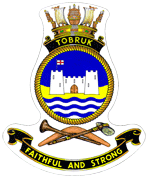
The Battle Class destroyer HMAS Tobruk was laid down at Cockatoo Island dockyard, Sydney on 5 August 1946 and launched on 20 December 1947 by Mrs W Riordan, wife of the Minister for the Navy. HMAS Tobruk commissioned at Sydney on 8 May 1950 under the command of Commander Thomas K Morrison, OBE, DSC, RAN.
The destroyer was the first ship to be named Tobruk in the RAN and was named in honour of the famous stand by Australian troops at Tobruk, Libya, in 1941.
After working up, Tobruk joined the fleet in January 1951 spending the first fifteen months of her career exercising in Australian waters.
In August 1951 she proceeded to Japan to join the United Nations naval forces for Korean War operations. Under the command of Commander Richard Peek, RAN, Tobruk began active operational duty in the Korean theatre on 3 October 1951 when she reported for duty on the screen of Commander Task Element 95.11 (USS Rendova) with HMC Ships Athabaskan and Sioux in company.
From this time until the destroyer returned to Sasebo on 18 October she remained on the screen of the American carrier, except for one day with Task Element 95.19, a group specially formed for combined air and bombardment strikes against the east coast sector.
The screen protecting Rendova usually consisted of three ships with occasionally a fourth. During the period, in addition to Tobruk, it comprised HMC Ships Athabaskan, Sioux and Cayuga, HM Ships Comus and Concord and US Ships Phillip, Nicholas, Hanna and Naifeh.
Tobruk began her second patrol, still screening Rendova, on 26 October and remained with the carrier during daily flying operations until 4 November when the two ships plus HMS Cockade proceeded for Sasebo.
On 8 November Tobruk began her third patrol, the venue changing to the east coast where she spent 12 days as one of a bombarding group (Task Group 95.2) attacking enemy points between Songjin and Chongjin. The highlight of the operation was the complete destruction of a southbound freight train during the middle watch of 18 November. On several occasions trains after being hit had escaped but on this occasion derailment enabled Tobruk to complete the destruction with 4.5-inch fire. One hundred and sixteen targets were engaged during the course of the operation and 1,200 rounds of 4.5-inch ammunition were expended.
On 19 November Tobruk joined Commander Task Group 95.8 (HMS Belfast) for a combined two day air and sea strike on Hungnam. The air element was provided by the carrier HMAS Sydney (III) after the bombardment group of Belfast, Van Galen and Tobruk had suppressed anti-aircraft batteries ashore. The Australian destroyer fired 321 rounds of 4.5-inch ammunition. On 21 November Tobruk returned to Kure.
On 28 November Tobruk began her fourth patrol and her third as one of the screen in support of the American carrier Rendova. This patrol, which eventually lengthened into 26 days, covered three sections as screen to Rendova and Sydney (III) and as a unit of Task Element 95.12, being the West Coast Bombardment Force.
The period as screen to Rendova ceased on 6 December when Tobruk proceeded to operate independently off Paengyong Do. It was Rendova’s last patrol of the war. On 7 December the destroyer joined Sydney (III) and operated with her until 17 December. On 15 December Tobruk anchored for the first time in 106 days and some 30,000 miles of steaming.
The third and final phase of the patrol, from 17 to 20 December, was spent attached to Task Element 95.12 (HM Ships Ceylon and Constance and US Ships Manchester and Eversole), harassing the enemy south of Sokto.
Tobruk commenced her fifth patrol on 1 January 1952 when she relieved HMS Whitesand Bay in the Haeju area, operating mainly in defence of Yongpyong-Do. Two or three bombardments were carried out daily during this phase and on 7 January Chomi Do was heavily attacked to prevent a threatened invasion of Yongmae Do. On 9 January Tobruk was relieved by Cayuga.
Tobruk’s sixth and last patrol of her first tour of duty in the Korean War began on 16 January 1952 when she joined the ships of Task Element 95.11 screening Sydney (III). Two days were spent in the Choda/Sokto area, at anti-invasion stations by night and desultory bombardment of enemy shore batteries by day. After a patrol marked chiefly by snow storms and gales, Tobruk proceeded for Sasebo on 25 January, bringing to a close her first tour of duty in the Korean War. At the end of her five months of service in the operational areas, Tobruk had steamed some 39,000 miles and fired 2316 rounds from her 4.5-inch guns.
Referring to Tobruk, the Flag Officer Second-in-Command, Far East Station, Rear Admiral A.K. Scott-Moncrieff, RN said ‘she had recently made her presence known to the Communist Forces in Korea.’ ‘Fitted with the very latest gunnery equipment’, he added ‘she has carried out pin-point bombardments on both coasts of Korea and has hit trains, railways, railway bridges and troop concentrations. During the 118 days she operated in the Commonwealth Group, Tobruk spent 89 days at sea and steamed about 27,000 miles. During the strike against Munognam in November she was one of the bombarding element which destroyed large areas of military installations. Tobruk returned to Australian waters on 22 February 1952.
Following six months in home waters, Tobruk in September 1952 escorted Sydney (III) to Manus Island and during the following month was engaged carrying out security patrols off the Monte Bello Islands, covering the explosion of the first British atomic bomb. The following seven months were all spent in Australian waters.
Tobruk returned to Korean waters on 26 June 1953 when she reported for duty to Commander Task Unit 95.1.2 (HMS Newcastle) at Taechong Do as relief to her sister ship HMAS Anzac (II) for west coast operations. On 27 June she joined the screening force covering the carrier HMS Ocean. This duty continued until Ocean was relieved by USS Bairoko on 5 July.
Tobruk's next mission was with Task Group 95.2 as part of the Yangdo Blockade and Patrol Group. She reached Yang Do on 14 July where she relieved HMCS Huron. Operations with this group continued until the close of hostilities on 27 July 1953. On 16 July Tobruk sank a large motor sampan suspected of operating as a mine-layer. She fired her last shots of the war on 24 July when she fired a few rounds of 4.5-inch ammunition at a radar post installation on Musudan Point between Chongjin and Yang Do.
Although hostilities ended on 27 July 1953, Tobruk continued to serve in Korean waters in the post war period, conducting post Armistice patrols until January 1954. During her second tour of duty in Korean waters she steamed 26,000 miles, including some 7,000 miles before the end of hostilities.
After a refit in the early part of 1954 she operated in Australian and New Guinea waters until June 1955 when she exercised with the fleet in Southeast Asian waters.
In June and July 1955 Tobruk served as a unit of the Far East Strategic Reserve, taking part in joint exercises. The succeeding years saw Tobruk return to the Far East on a number of occasions as part of the Australian commitment to the Far East Strategic Reserve.
She had longer tours of duty during the periods of December 1955 to October 1956.
On 26 April 1957 Tobruk was taking part in a night encounter exercise while participating in SEATO Exercise ASTRA. The opposing forces were designated ‘blue’ and ‘orange’ respectively and the purpose of the exercise was to detect and engage the opposition in a night action environment.
Shortly after 21:00 hours Tobruk was steaming as the third, and rear ship, in a Blue Force column lead by HMS Newcastle steering 340 at 25 knots. HMAS Anzac was the second ship in the column ahead of Tobruk. Each ship was 2000 yards apart. At approximately 21:10, star shell bursts were observed by Tobruk to the west of Anzac as the column was executing a turn together to port, to course 160. Several minutes later Tobruk and Anzac were ordered by Newcastle to form on a line of bearing and the course was altered to 130. At 21:17 reports were issued from Tobruk indicating that shells were falling very close to each side of the ship and shortly afterwards she was hit by a shell that passed inboard through the upper deck into ‘A’ gun bay where it detonated critically injuring two ratings: Able Seaman RW Spooner and Able Seaman JR Stevenson. Able Seaman Spooner subsequently died of his wounds.
A board of inquiry into the tragedy revealed that a star shell fired from HMS Cockade during the night encounter exercise was responsible for the damage to Tobruk and her casualties. Able Seaman Robert William Spooner was buried at sea the following day with full naval honours. He is commemorated on the Roll of Honour at the Australian War Memorial, Canberra, on the following link: https://www.awm.gov.au/collection/R1716077
Two members of Tobruk's ship's company, Lieutenant George Halley, RAN and Leading Sick Berth Attendant Lionel George Whitten, received Naval Board Commendations for their part in rushing to the aid of the two injured ratings and administering first aid.
Tobruk continued to operate in south east Asian waters in 1957, 1958 and 1959. During that time time RAN ships carried out several goodwill visits to the Republic of Vietnam. The first of these occurred when HMAS Anzac (II) visited Saigon in October 1956 for the observance of Vietnamese National Day. She was followed by Tobruk which visited Saigon in December 1957 and Cam Ranh Bay in September 1959. The purpose of these visits was to demonstrate Australia's support for the ruling non-Communist Vietnamese Government.
During the 1959 deployment an unfortunate incident saw one of Tobruk's ship-launched torpedos accidentally fired while the tubes were fixed in the fore and aft position. The torpedo entered the after deck house screen lodging itself in one of the ships bathrooms. Fortunately all onboard escaped injury.
Following a refit in 1960, Tobruk joined Anzac (II) for a cruise to Noumea and to various ports in New Guinea. In September 1960, while exercising with the fleet off the east coast of Australia, she was accidentally hit by a shell from Anzac (II). After effecting repairs at Jervis Bay, Tobruk sailed for Sydney where she paid off into Reserve on 29 October 1960. During her service Tobruk steamed 299,946 miles.
Tobruk was sold for scrap on 15 February 1972 to the Fujita Salvage Company Limited of Osaka, Japan. On 10 April 1972 the Japanese ocean going tug Sumi Maru 38 sailed from Sydney for Moji, Japan, with Tobruk and another former Australian ship, HMAS Quiberon, under tow.

